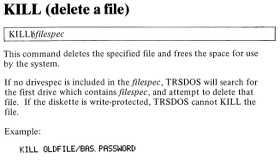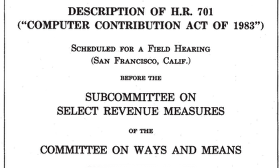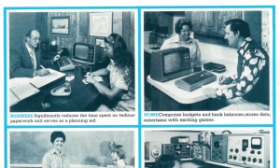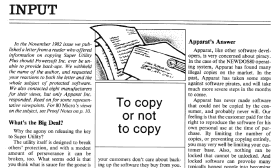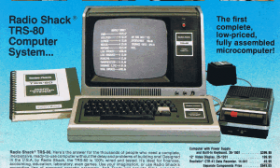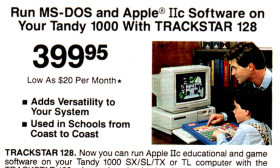Articles in the "History" Category
The KILL command was probably the most unusually named command in the TRSDOS disk operating systems for TRS-80 computers. KILL was used to delete a file, for example: KILL FILENAME/EXT.
The KILL command was supported by versions of TRSDOS for the Model I, Model III, and Model II, as well as the BASIC interpreters for all those machines plus the Model 4, Color Computer, the Model 100, Model 102, Model 200, and the Model 2000. In addition, all of the TRSDOS-compatible TRS-80 Model I/III operating systems (NEWDOS, MULTIDOS, DOSPLUS, and LDOS) also implemented the KILL command.
The use of KILL as a command was somewhat controversial and many people objected to the connotation. Here’s what Josef Friedman said about KILL in his article “Thou Shalt Not Kill” in the November 1984 issue of 80 Micro:
(Read more...)
Almost as soon as microcomputers became widely available to consumers in 1977, there were efforts to place them in classrooms. Both Apple (with the Apple II) and Radio Shack (with the TRS-80 Model I) concentrated heavily on education and school sales. By 1982, it was unclear which company had the edge when it came to computers in schools. There was a great deal of conflicting information, some showing Apple ahead and some with Radio Shack as the leader. As late as 1985, Radio Shack claimed that there were “more TRS‑80 computers in America’s schools than any other brand.”
Either way, both companies were heavily involved in the education market. At the time, 25% of Apple’s revenue came from educational sales. Both companies had compelling reasons to get their computers in schools and build their brand awareness among schoolchildren. Beyond those reasons, people at both companies felt that computers in schools were the future. In a 1995 interview with the Smithsonian Institution, Apple co-founder Steve Jobs recalled their plan to make that happen:
(Read more...)
August 3 marks the 46th anniversary of the introduction of the Radio Shack TRS-80 Microcomputer System, a significant date in the history of personal computers. The TRS-80, later known as the TRS-80 Model I, was one of the first mass-marketed, fully-assembled computers and it dominated the early microcomputer market.
(Read more...)
Software piracy and copy protection were hotly debated issues during the early years of the TRS-80 software market. Piracy was blamed (not entirely fairly) for lost sales and the decline of the TRS-80 games market in 1982. As a result, a good percentage of TRS-80 games were copy protected.
(Read more...)
Now that the Radio Shack computer project had been approved by Charles Tandy, the question was how many computers to build. Steve Leininger and Don French both felt that 50,000 units was a reasonable number. That figure was considered laughable (literally) by those in charge, who felt that 1,000 units was more reasonable. (A number that seems absurdly low when you consider that MITS sold 1,000 Altair computers in February 1975 alone.)
The 1,000 target was later increased to 3,000. At the time, Radio Shack had slightly over 3,000 stores. It was decided that if the computer failed to sell, the 3,000 units built could be used in the stores to keep inventory.
Actually, French described it as being phrased “when” the computer failed to sell. There was very little confidence in the project in the upper levels of management at Radio Shack. According to a 1981 InfoWorld article, one executive expressed his disapproval to French with this message: “Don’t waste my time – we can’t sell computers.”
(Read more...)
Jim Pickett wrote with an interesting question:
I seem to remember that you could look through some of the early TRSDOS disks with SuperZap (a wonderful program) and in some of the blank spots, i.e., unused disk space not holding part of a program, and it had a message like “You rummy buzzard, you” or something like that. The “rummy buzzard” part was the only sure thing.
I did a Google search on “rummy buzzard” but didn’t get any hits. Does anyone remember this?
Many people encountered that “rummy buzzard” message in Model III TRSDOS and several explanations were devised to explain it.
The best remembered explanation is the “Joe, you rummy buzzard” story. It was related as fact in magazines such as [80 Micro][1] and several user group newsletters, but I don’t think it is true, for reasons explained later. Here is the overview:
(Read more...)
One of the biggest weaknesses of the TRS-80 Model I was the lack of lowercase characters on the screen. Although that omission was hardly unique to the Model I (many computers at the time lacked lowercase, including the Apple II), it was still a notable limitation that affected many applications, especially word processing.
The two people most responsible for the Model I (originally known as the Radio Shack TRS-80 Microcomputer System) were Don French and Steve Leininger. Don French, described as “the originator of the TRS-80 project,” was a buyer for Radio Shack who had long pushed for Radio Shack to manufacture a microcomputer. Steve Leininger was the engineer who designed almost all of the hardware of the Model I and created the original Level I BASIC.
Steve Leininger mentioned lowercase in a talk he gave to the San Diego Computer Society in September 1977, just one month after the TRS-80 was introduced:
(Read more...)
After Radio Shack introduced their MS-DOS compatible Model 1000 series, there were persistent rumors about a Model 4 emulation card that was being developed. Such a board would have been an clever way to help migrate Model 4 customers to the newer MS-DOS computers. Some people were even told at their Radio Shack stores that a Model 4 emulator would be released soon. But it never happened and no type of TRS-80 emulator was ever released by Radio Shack.
At the time, Radio Shack sold the Trackstar 128, an Apple IIc emulator card created by Diamond Computer Systems. The Trackstar used actual Apple II ROMs (licensed from Apple) along with custom hardware to achieve nearly 100% Apple compatibility. So the concept of a Model 4 emulation card certainly must have occurred to people at Radio Shack.
I’ve had three different people write to me (years apart) recalling details of a Model 4 emulation project that Radio Shack worked on but pulled at a very late stage. Their accounts match in almost all the details.
(Read more...)
